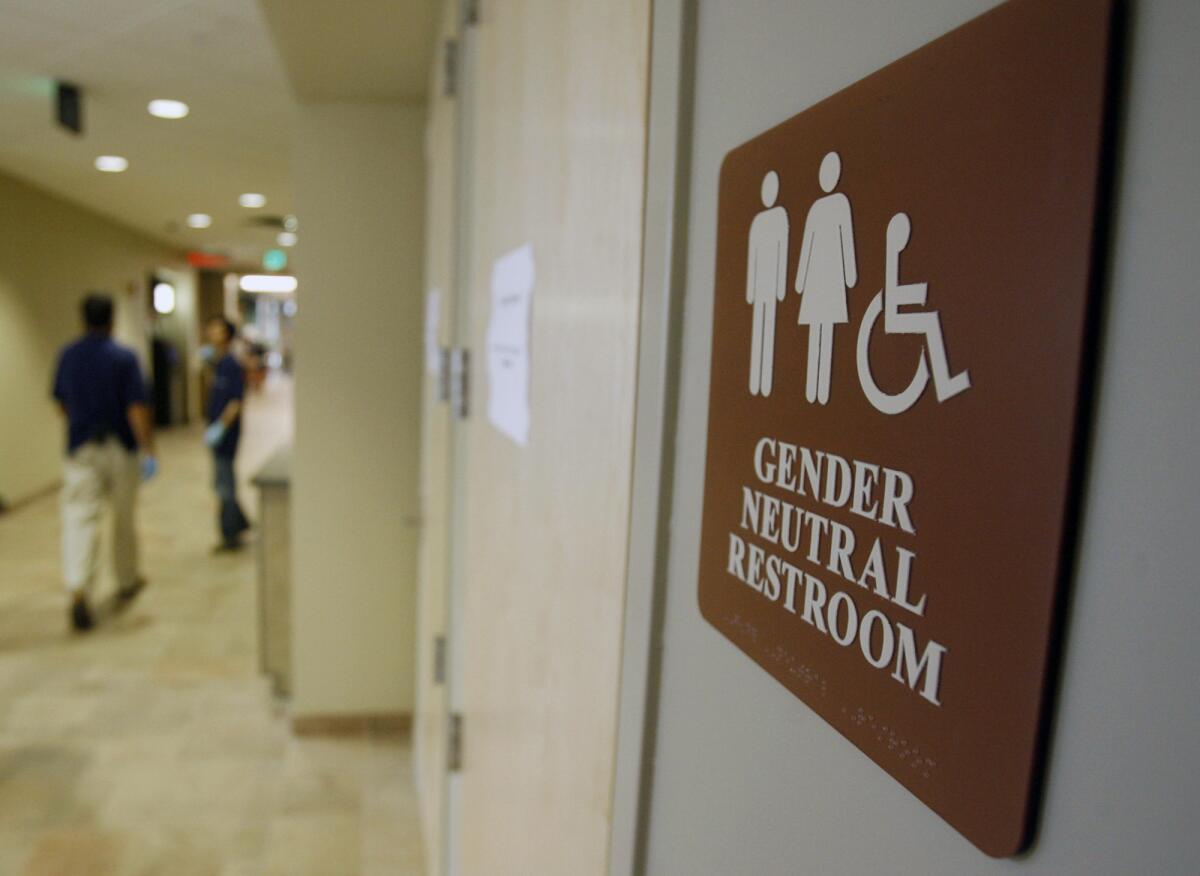Op-Ed: How to stamp out the transgender ‘bathroom panic’

A sign marks the entrance to a gender-neutral restroom at the University of Vermont in Burlington in Feburary 2007.
- Share via
Social conservatives in North Carolina used a familiar playbook when they helped pass a draconian law restricting which restrooms transgender people can use. The tactic was fear: They whipped up anxieties about modesty and vulnerability in public restrooms until they created full-fledged “bathroom panic” over victimization by sexual predators. This week, with banks, businesses and Bruce Springsteen announcing boycotts to protest the discriminatory law, North Carolina Gov. Pat McCrory announced half-measures to try to dampen the backlash, but he did nothing to alter the deception inherent in bathroom panic.
The North Carolina law, House Bill 2, took aim at an ordinance that was about to go into effect in Charlotte, N.C. The Charlotte City Council had voted to prohibit discrimination against gay and transgender people in public accommodations and by government contractors, expanding an existing law that protected other minorities. In response, the state legislature invalidated the ordinance and seized the opportunity to target transgender people using the crudest — and most baseless — of fears: “No men in women’s bathrooms.”
When McCrory signed HB2 into law, he claimed he was protecting the “basic expectation of privacy in the most personal of settings” and acting to stop a “radical breach of trust and security.” Peter Sprigg of the conservative Family Research Council defended the need to force transgender people into restrooms aligned with their birth gender by citing “legitimate fears that people have about their safety.” Yet hundreds of similar nondiscrimination measures are in place across America, and law enforcement officials have reported no surge in bathroom victimization as a result.
Sprigg and company borrowed their playbook from a successful effort in Houston last year. With a ballot measure, voters there repealed a nondiscrimination ordinance after a campaign that included an ominous television ad showing a man in a dress following a little girl into a bathroom stall.
As the New York Times reported, the ballot measure fight was turned “from one about equal rights to one about protecting women and girls from sexual predators.” The anti-discrimination ordinance lost, 61% to 39%.
Fear mongering against gays and transgender people is a time-tested strategy, despite plenty of evidence that there is nothing to fear but fear itself.
Such fear mongering against gays and transgender people is a time-tested strategy, despite plenty of evidence that there is nothing to fear but fear itself. In the battle for marriage equality, the nation was told time and again that marriage itself, along with the American family, would be imperiled if same-sex couples were allowed to marry. “Freedom will be taken away,” said one infamous 2009 ad titled “Gathering Storm.” Religion would be destroyed because the clergy would be forced to conduct same-sex weddings, no matter their convictions. Yet none of these doomsday scenarios has come to pass.
The particular terrors that fueled the campaigns in Houston and North Carolina have an even longer history. In the debate over “don’t ask, don’t tell,” opponents of openly gay service spent decades fanning the flames of anxiety about straight recruits sharing quarters — sharing showers! — with known gays and lesbians. At one point, senators held congressional hearings in the bowels of a nuclear submarine to infuse the news cycle with frightening images of the compromised privacy of military life. The message was clear: In such conditions, gay people were not to be trusted, unit cohesion could not be maintained and an inclusive policy would be a clear and present danger to the United States.
Again, none of this was true, as a wealth of research before and after “don’t ask, don’t tell” concluded (some of it was buried by those opposed to change).
A 2003 Palm Center study found that the experience of military and paramilitary organizations that lifted their gay bans showed that “cohesion, morale, recruitment, retention and privacy will be preserved or even enhanced” by ending policies that required gay people to lie about their identities or stay out of uniform. Other scholars noted that, all across the globe, people in various contexts that might seem erotic (especially when social conservatives insisted on eroticizing them) in fact developed an “etiquette of disregard.” In doctor’s offices, in military barracks, in locker rooms and restrooms, most people simply finished their business and ignored those around them. Those who had predicted disaster were spectacularly wrong.
But no amount of evidence seems capable of stopping the fear strategy. The Rand Corp. has completed a new study on transgender military service concluding, unsurprisingly, that ending discrimination against transgender troops will not harm military readiness. The Pentagon has neither released the study nor met its own deadline for reviewing the policy. Sen. James M. Inhofe (R-Okla.), who wrongly predicted that openly gay military service would “complicate things” and “make it very difficult for us to take care of the troops,” is now opposing service by transgender troops because — guess what — he can’t understand which bathrooms they would use. And Elaine Donnelly, president of the Center for Military Readiness, who had earlier wrongly predicted that openly gay troops would drive away one-quarter of the military, is now predicting that transgender service will increase sexual assaults.
Voters should see these kinds of fear-based charges for what they are — a cynical, angry and wildly inaccurate response to LGBT people gaining equal rights. In the barracks and at the marriage altar and in the bathroom, equality for sexual minorities does not cause harm to others.
Nathaniel Frank is the director of the What We Know Project at Columbia Law School. He is completing a book on the history of the marriage equality fight.
Follow the Opinion section on Twitter @latimesopinion and Facebook
More to Read
A cure for the common opinion
Get thought-provoking perspectives with our weekly newsletter.
You may occasionally receive promotional content from the Los Angeles Times.










